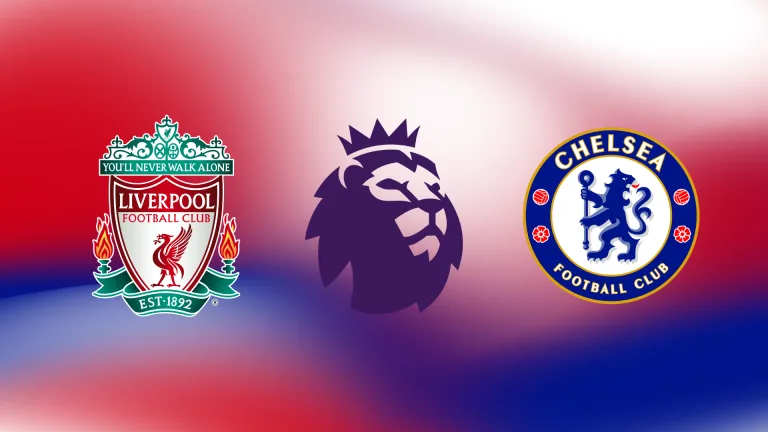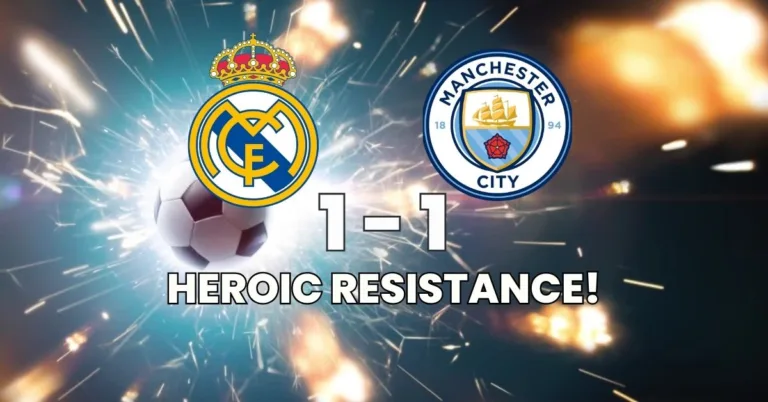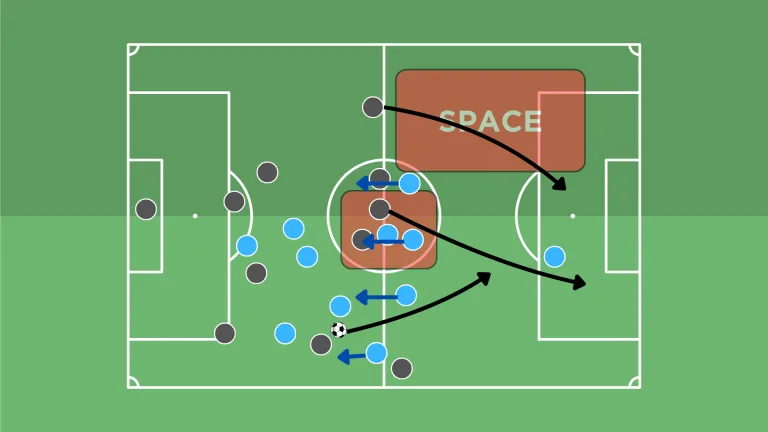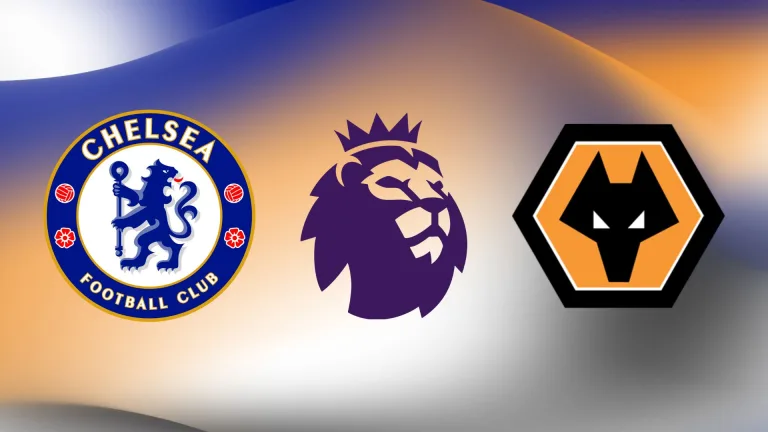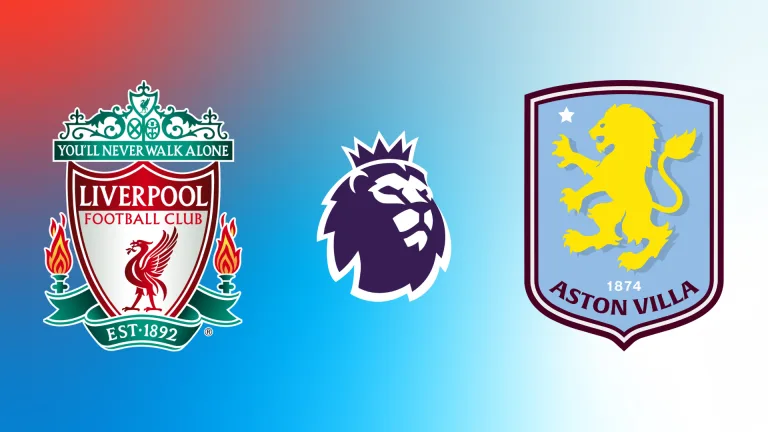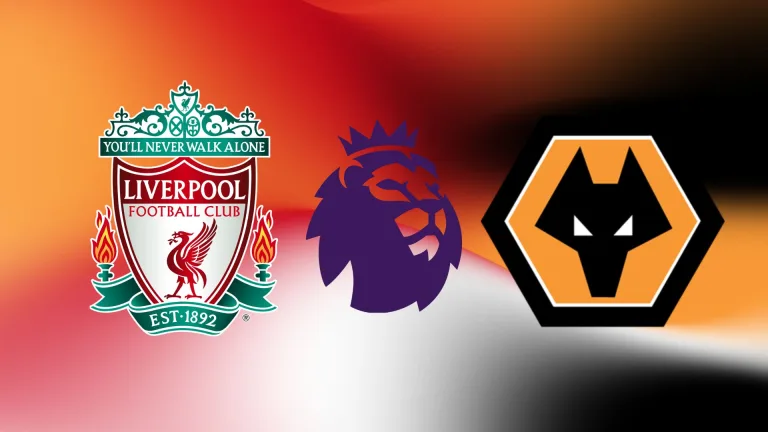Tactical Breakdown: Manchester City vs Brighton – Key Stats and Strategies
Manchester City has won their rescheduled match against Brighton & Hove Albion, securing a dominant 4-0 victory. This marks the fourth consecutive game where Pep Guardiola’s team has scored at least four goals.
Following their elimination from the UEFA Champions League by Real Madrid, City is now fully focused on defending their Premier League title. They currently sit in second place in the standings, just one point behind leaders Liverpool with only three matches remaining.
Table of Contents
Starting Lineups
Brighton’s 4-2-3-1 formation, favored by manager Roberto De Zerbi, is known for its versatility, striking a balance between defense and offense. It features two defensive midfielders who provide support to the backline, allowing the three attacking midfielders and the striker to focus on attacking.
In contrast, Pep Guardiola’s frequently used 4-1-4-1 formation emphasizes midfield control by deploying a single defensive midfielder, Rodri, between the backline and the midfield.
Injury Updates:
- Brighton: The Seagulls are severely hampered by injuries, with nine players out, including key figures like Jack Hinshelwood, Kaoru Mitoma, and Tariq Lamptey.
- Manchester City: The notable absence for City is Erling Haaland, who is replaced in this match by Julian Alvarez.
Match Summary
Kevin De Bruyne Scores the Opener
The game started strongly for the visitors, with Kevin De Bruyne scoring a remarkable header in the 17th minute, perfectly finishing a cross from Kyle Walker. This goal was the result of excellent positioning by De Bruyne, who effectively exploited the open space left in the opponent’s box.
Phil Foden’s Double Ends the First Half
Pep Guardiola’s team kept up the pace, and Phil Foden scored two goals at the 26th and 34th minutes. His first goal followed a controversial free kick, awarded after a debatable decision by the referee. Although replays suggested that Foden might have slipped rather than been fouled, he executed the free kick, which was deflected and led to the doubling of the visitors’ advantage. His second goal came after a mistake in the opposition’s buildup, with Foden finishing efficiently to the far post.
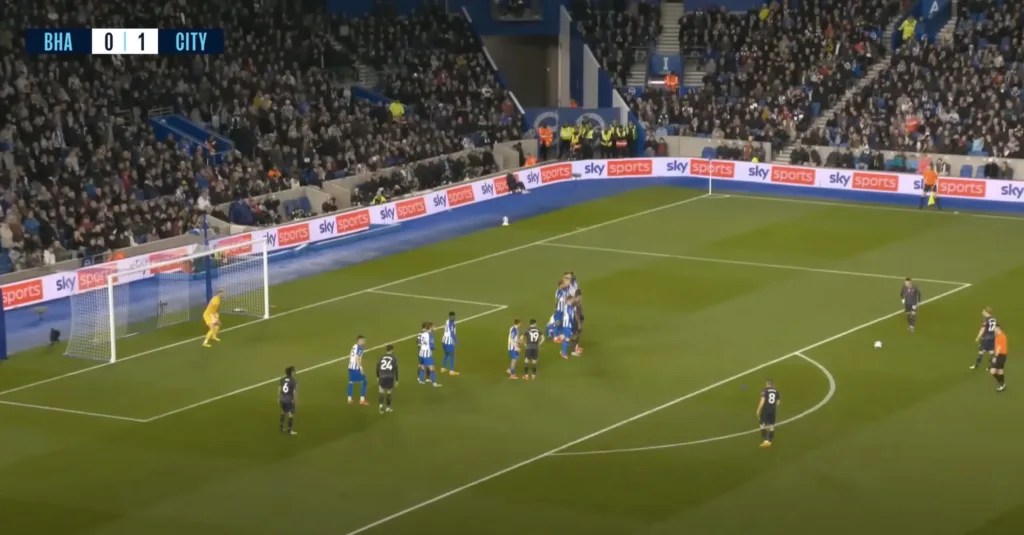
Julian Alvarez Seals the Scoreboard
By halftime, Manchester City had secured complete control of the game, and in the second half, Julian Alvarez scored the fourth goal in the 62nd minute, completing an excellent move started by a long pass that found Kyle Walker free behind the opponent’s defense. Alvarez elegantly bypassed Valentin Barco and defeated the opposing goalkeeper, consolidating his team’s advantage.
Tactical Analysis
Seagulls’ Pressing Cuts Passing Lines
Brighton employs a pressing strategy that lies somewhere between man-to-man and zonal, focusing more on hindering the opponents’ advance rather than on ball recovery. They position themselves in a way that makes it difficult for City to advance. Notably, Brighton does not have issues when City holds possession in the defensive line; they do not attack or press in the same manner as City. For instance, when Kevin De Bruyne drops back to assist in the buildup, he is left unmarked by his direct opponent in the defensive zone.
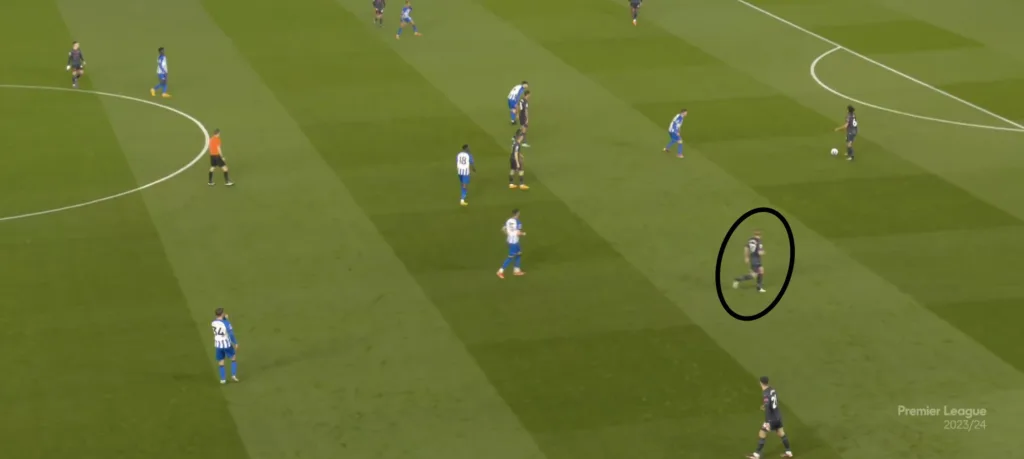
The pressing creates difficulties in the buildup phase for the visitors, who find it harder than usual to advance and circulate the ball in the back, attempting to find exploitable spaces. Their pressing is compact at the center of the field, as can be seen in the above image, with four Brighton players concentrated in the center. However, they do not hesitate to adopt a wider stance to prevent long switches from one flank to the other.
City’s Buildup
As usual, City builds from the back, starting with Ederson and the two central defenders. Gvardiol and Walker, the full-backs, advance and do not maintain the line with the central defenders, and at times, we can see Phil Foden and Julian Alvarez dropping back to draw pressure and create space in the center of the field behind them.
City patiently seeks opportunities, circulating the ball along the backline to find spaces in the center of the field. When they find these spaces, they explosively run to occupy them and advance the ball into the opponent’s half.
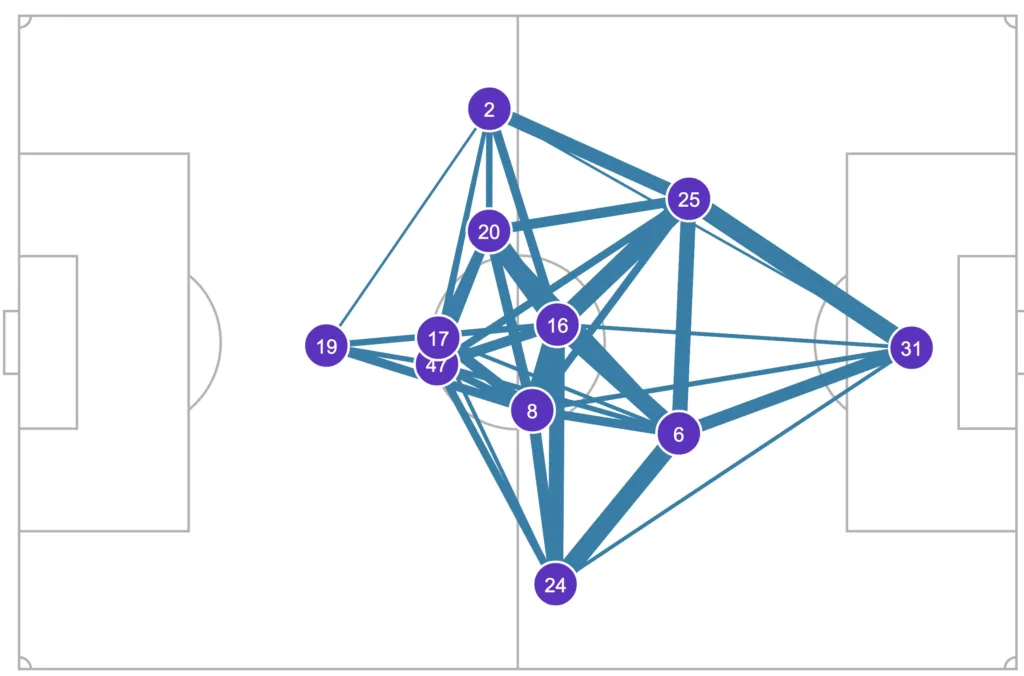
Looking at the above passing map, several key aspects can be observed. Firstly, the average high positions of Kyle Walker (2) and Gvardiol (24) are noticeable. Additionally, it is evident that Rodri has been a central hub for distributing the ball, with most passes (the thickest lines) occurring in the guests’ half of the field, between the central defenders and Rodri. The average positions of De Bruyne and Foden illustrate their freedom of movement, with their average positions being in the midfield.
When they fail to break through the first line of the opponents’ pressing, they pass back to Ederson, who then tries to send long passes behind Brighton’s defensive line. For example, this is precisely how City’s fourth goal was scored, through a long pass to Kyle Walker, who was very advanced on the wing.
De Zerbi’s Buildup Strategy
De Zerbi opts for a buildup from the back, characteristic of his style, with the full-backs also advancing forward while the defensive midfielders drop to the edge of the box. His philosophy is based on drawing the aggressive pressing of City players and congesting one side of the field, using short passes to quickly break from the press and to exploit the spaces left by the advancing City players.
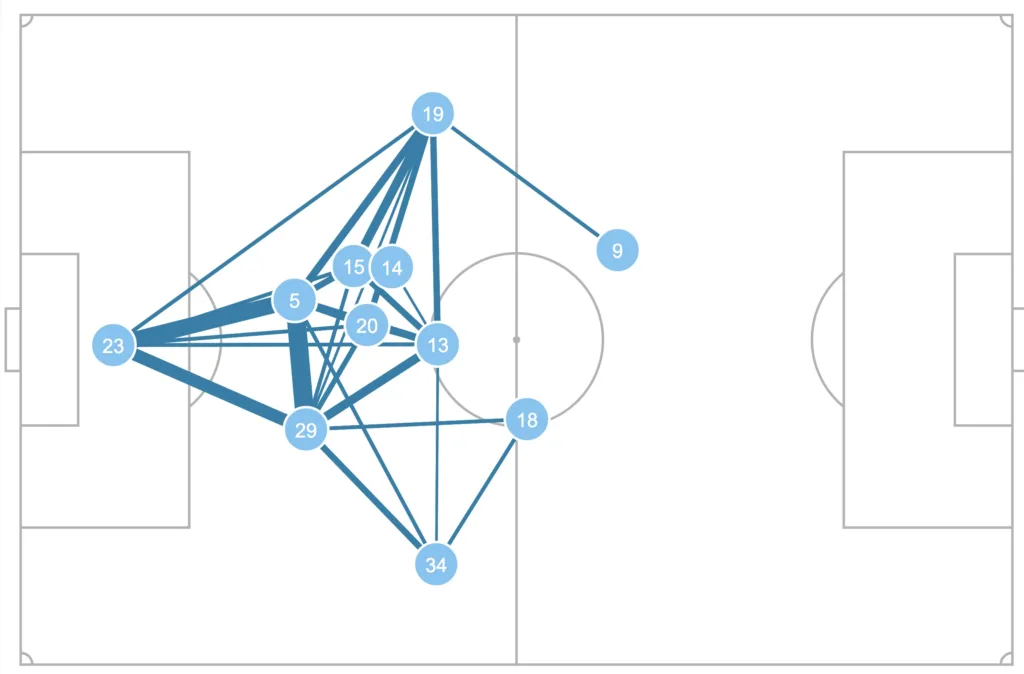
At Brighton, the clustering of players in the center of the field suggests a game based on short passing. The close average positions of the players indicate this style, and when space appears, the ball is passed to Barco, who then launches it to Joao Pedro.
Jason Steele plays a key role in De Zerbi’s construction, functioning as a central defender in the Seagulls’ setup. He is comfortable receiving the ball, and we see several instances where he manages to dribble to avoid the pressing City players.
The weakness of this method of construction is the need for experienced players who are calm under pressure. A weak link for Brighton is Valentin Barco, a young and inexperienced player whose mistake in the buildup phase led to City’s third goal when his pass was intercepted at the edge of the box.
Key Statistics
Manchester City dominated possession, maintaining control of the ball 65% of the time. In terms of shots, Manchester City had 14 shots, 6 of which were on target, doubling Brighton’s count of 7 shots, 3 of which were on target.
An interesting statistic that well illustrates the game strategy of both teams is the number of offsides, with Brighton caught offside 5 times during this match. This indicates that Brighton relied on drawing City’s pressing to free up space at the back, so they could launch forwards with long passes that took the ball out of pressure.
In passing statistics, Manchester City leads with 786 completed passes, having an accuracy of 93%, while Brighton managed to complete 421 passes with an accuracy of 89%.
Conclusions
This victory was crucial for City, who cannot afford mistakes for the rest of the season to secure the championship title. They have closed to within one point of league leaders Arsenal, but have a game in hand. Brighton, on the other hand, remains in 11th place, a good position not under any threat of relegation but no longer able to aspire for a spot in European competitions.

